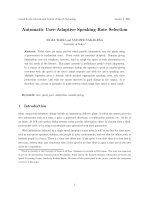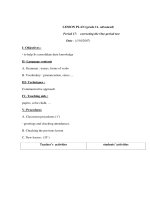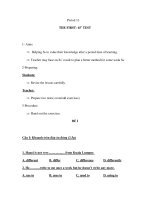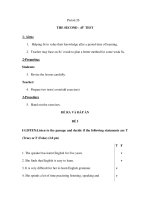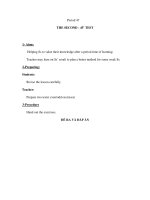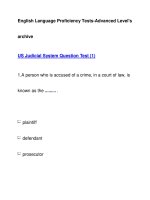Sample Speaking PET test.PDF
Bạn đang xem bản rút gọn của tài liệu. Xem và tải ngay bản đầy đủ của tài liệu tại đây (1.12 MB, 16 trang )
Sample Speaking Test Student Worksheets KET Introduction
page 1
Introduction
Aims of the video and worksheets
• to show you the KET Speaking Tests.
• to let you think about how to improve your speaking in English.
• to give you time to practise the language used in the different parts of the test.
Please note:
The video and worksheets are not to be used to talk about grades. In some questions we will look at
how the candidates speak. This is to help you with your own speaking.
The tests on the video are for teaching only, and so there are no grades given.
Please turn over for the Student’s Introductory Worksheet
Sample Speaking Test Student Worksheets KET Introduction
page 2
Student’s Introductory Worksheet (3 tasks)
Watch the video and complete the worksheet:
TASK ONE
Read the following statements and write ‘True’ or ‘False’ next to each one.
1. The normal format of the test is 2 candidates and 2 examiners. __________________
2. Both the examiners ask questions during the test. __________________
3. The examiner gives the candidates their marks at the end of the test. __________________
4. The candidates may not know each other. __________________
TASK TWO
Fill in the missing information:
Length: ____________________ minutes.
Usual format: 2 candidates and ____________________ examiners.
The interlocutor tells the candidates what to do.
The assessor listens to the candidates.
Number of parts ____________________
TASK THREE
Complete the table with the missing information:
PART TIMING TASK FORMAT TYPE OF LANGUAGE USED
The examiner asks the
candidates questions.
Candidates ask and answer
questions using a card.
Answering questions and
giving personal information
Talking about factual
information of a non-personal
kind related to daily life
_____ minutes
1. Personal
information
2. Prompt card
activity
_____ minutes
Sample Speaking Test Student Worksheets KET Part 1
page 3
Student’s Worksheet One – Part 1 (5 tasks)
TASK ONE
Read the three statements below, watch Part 1 of the sample KET Speaking Test and write ‘True’ or
‘False’ next to each one.
1. In Part 1, you must talk to your partner. __________________
2. You must spell your name. __________________
3. The examiner asks you questions about yourself. __________________
TASK TWO
Watch Part 1 of the test again and tick (✓) the topics listed below that the candidates talk about.
1. [ ] Home town 7. [ ] Music
2. [ ] Family 8. [ ] Hobbies
3. [ ] Work 9. [ ] Free time
4. [ ] Weekend activities 10. [ ] Travel
5. [ ] Studies 11. [ ] Future plans
6. [ ] House or flat 12. [ ] Other countries
TASK THREE
Now watch the last section of Part 1 again. What does the examiner say?
Julio, _______________________ about your family.
Tuba, _______________________ about Troy (her home town).
TASK FOUR
Write down some of the words they use to talk about their family or home town. Discuss your answers
with your class.
Julio
Tuba
Sample Speaking Test Student Worksheets KET Part 1
page 4
TASK FIVE
Work in pairs. Find out about your partner’s family and home town. Use the same words as the
examiner.
page 5
Student’s Worksheet Two – Part 2 (3 tasks)
TASK ONE
Read the following statements, watch Part 2 and write ‘True’ or ‘False’ next to each one.
1. In this part you talk to your partner. __________________
2. The examiner gives you a card. __________________
3. You must not let your partner see your card. __________________
TASK TWO
Watch Part 2 again. What does the examiner say?
Julio, here is some information about a ____________________ club.
Tuba, you don’t know anything about the ____________________ club, so ask Julio some questions
about it. Use these words to help you.
Do you understand?
Tuba, here is some information about a ____________________ .
Julio, you don’t know anything about the __________________ , so ask Tuba some questions about it.
Use these words to help you.
Do you understand?
Sample Speaking Test Student Worksheets KET Part 2
Sample Speaking Test Student Worksheets KET Part 2
page 6
TASK THREE
This is what was on the candidate’s information cards. Write the questions using the correct grammar.
Now watch part 2 again. What do the candidates say? If their question is the same as yours put a
tick (✓) next to it. If it is different, put a cross next to it. Cross (x)
Who is correct, you or the candidate? Discuss the answers with your teacher.
TUBA’S QUESTIONS
TICK (✓) OR
CROSS (X)
when/open?
address?
cost? £?
lessons every day?
phone number?
JULIO’S QUESTIONS
what music?
where?
day?
student ticket?
start?
Sample Speaking Test Student Worksheets KET Dos and Don’ts
page 7
Dos and Don’ts
Do
• Do make sure you know what will happen in both parts of the Speaking Test.
• Do practise your English in groups and pairs before the test.
• Do listen carefully to the instructions and questions in both parts of the test.
• Do answer questions carefully.
• Do speak to the examiner in Part 1.
• Do speak to your partner in Part 2.
• Do speak clearly so that both examiners can hear you.
Don’t
• Don’t worry if you don’t understand what to do. Just ask the examiner to repeat the instruction.
• Don’t prepare long responses in advance.
• Don’t worry if the examiner stops you. It is important that the tests are not too long.
Sample Speaking Test Student Worksheets PET Introduction
page 8
Introduction
Aims of the video and worksheets
• to show you the PET Speaking Tests.
• to let you think about how to improve your speaking in English.
• to give you time to practise the language used in the different parts of the test.
Please note:
The video and worksheets are not to be used to talk about grades. In some questions we will look at
how the candidates speak. This is to help you with your own speaking.
The tests on the video are for teaching only, and so there are no grades given.
Some of the answers to the activities in the worksheets cannot be found in the
video.
Please turn over for the Student’s Introductory Worksheet
Sample Speaking Test Student Worksheets PET Introduction
page 9
Student’s Introductory Worksheet (3 tasks)
Watch the video and complete the worksheet.
TASK ONE
Read the following statements and write ‘True’ or ‘False’ next to each one.
1. The normal format of the test is 2 candidates and 2 examiners. __________________
2. Both the examiners ask questions during the test. __________________
3. The examiner gives the candidates their marks at the end of the test. __________________
4. The candidates may not know each other. __________________
TASK TWO
Fill in the missing information:
Length: ____________________ minutes
Usual format: ____________________ candidates and __________________________ examiners
The interlocutor ____________________ the candidates what to do.
The assessor ____________________ to the candidates.
Number of parts: ____________________
TASK THREE
Complete the table with the missing information:
PART TIMING TASK FORMAT TYPE OF LANGUAGE USED
The interlocutor asks each
candidate questions.
Candidates talk to each
other about a situation, using
a visual prompt.
Candidates each talk about a
photograph.
Candidates talk about a topic
from the photos in Part 3.
Giving personal information,
answering questions
Making suggestions and
discussing alternatives
Describing the activities and
setting of a photograph
Talking about your likes,
dislikes, habits and things you
have done
_____minutes
1. Personal
information
2. Simulated
situation
3. Responding to
photographs
4. Discussion
____ minutes
____ minutes
____ minutes
Sample Speaking Test Student Worksheets PET Part 1
page 10
Student’s Worksheet One – Part 1 (5 tasks)
TASK ONE
Read the three statements below. Watch Part 1 of the sample PET Speaking Test. Write ‘True’ or ‘False’
next to each one.
1. You must spell your name. __________________
2. You should prepare long responses in advance. __________________
3. In Part 1, you must talk to the interlocutor. __________________
TASK TWO
Watch Part 1 of the test again and tick (✓) the topics listed below that the candidates talk about.
1. [ ] Home town 6. [ ] Studies
2. [ ] Work 7. [ ] Holidays
3. [ ] Family 8. [ ] Future plans
4. [ ] Travel 9. [ ] Evening activities
5. [ ] Free time activities 10. [ ] Studying English
TASK THREE
Now watch (the last part of) Part 1 again. Fill in the missing words.
‘Eva, do you enjoy ____________________ ____________________ ?’ Why?
‘Berta, do you think that __________________ will be useful for you in the __________________?’
‘Eva, what did you do ____________________ ____________________ ?’
‘Berta, what do you ________________ doing in your _________________ _________________?’
TASK FOUR
Look at the questions from Part 1 again (in Task Three). With your partner, ask and answer the
questions.
TASK FIVE
In pairs, practise talking to your partner. Pretend you don’t know each other and ask your partner some
questions about all the topics listed in Task Two (above).
Sample Speaking Test Student Worksheets PET Part 2
page 11
Student’s Worksheet Two – Part 2 (5 tasks)
TASK ONE
Read the three statements below. Watch Part 2 of the sample PET Speaking Test. Write ‘True’ or ‘False’
next to each one.
1. The examiner always repeats the instruction. ____________________
2. The examiner takes part in the conversation. ____________________
3. You should only talk about the pictures on the piece of paper. ____________________
TASK TWO
Watch Part 2 again. What does the examiner say?
“I’m going to describe a situation to you. A friend of yours is planning to spend six months in England to
improve her English. Talk together about ________________________________________ and decide
which are ________________________________________”
TASK THREE
The pictures in the prompt sheet showed the following items:
• a camera and rolls of film
• a map and guide books
• money
• a cassette player
• a coat, umbrella, gloves and hat
Discuss what other items you could talk about.
Sample Speaking Test Student Worksheets KET Introduction
page 12
Sample Speaking Test Student Worksheets PET Part 2
TASK FOUR
Watch Part 2 again and answer these questions.
1. How did Eva start the discussion?
2. Berta talks about her own experience. What did she find useful? Why?
3. What does Eva say when she hears about the rain?
4. Both talk about the radio cassette player. Why do they think it is useful?
5. What did Eva decide was the most important to bring?
TASK FIVE
In pairs, talk about the different things you can do to improve your English. Discuss your answers with
the whole class and decide which ideas are the best.
Sample Speaking Test Student Worksheets KET Introduction
page 13
Sample Speaking Test Student Worksheets PET Part 3
Student’s Worksheet Three – Part 3 (4 tasks)
TASK ONE
Read the following statements. Watch Part 3. Write ‘True’ or ‘False’ next to each one.
1. You should talk on your own for about one minute. __________________
2. You will have time to prepare. __________________
3. You will have one photograph to talk about. __________________
4. You must not show your photograph to your partner. __________________
5. You should not worry if the examiner interrupts you. __________________
TASK TWO
Watch Part 3 again and answer these questions:
1. What is the topic of the photographs?
2. Make some notes about the things they mention in their photographs.
Then discuss these with your class.
Berta:
Eva:
Sample Speaking Test Student Worksheets KET Introduction
page 14
Sample Speaking Test Student Worksheets PET Part 3
TASK THREE
Your teacher will explain what the examiners are listening for when they mark the Speaking Test. Listen
to your teacher’s explanation:
Grammar and Vocabulary
Discourse Management
Pronunciation
Interactive Communication
Your teacher will give you some photographs of people doing different things (at home). Practise
describing the people and activities in the photographs. Try to remember what the examiners are
listening for.
TASK FOUR
Find some photographs of people doing different activities. Either bring in your own family photos or
look in some magazines. Bring them in to your class to practise describing them in another lesson.
Sample Speaking Test Student Worksheets KET Introduction
page 15
Sample Speaking Test Student Worksheets PET Part 4
Student’s Worksheet Four – Part 4 (4 tasks)
TASK ONE
Read the following statements. Watch Part 4. Write ‘True’ or ‘False’ next to each one.
1. You can keep the photographs for part 4. __________________
2. You only talk to your partner in this part. __________________
TASK TWO
Now watch Part 4 again. What does the examiner say?
“Now talk together about the type of ___________________ you like to ___________________ or
____________________ and other ways you ____________________ .”
TASK THREE
Watch Part 4 again. Look at how the candidates do the task. How do you think they could do better?
Positive points:
Improvements:
TASK FOUR
In pairs, practise doing the task as described in Task Two above. Try to keep the conversation going for as
long as possible by asking questions about what your partner tells you.
Sample Speaking Test Student Worksheets PET Dos and Don’ts
page 16
Dos and Don’ts
Do
• Do make sure you know about all parts of the test.
• Do practise your English in groups and pairs before the test.
• Do listen carefully to instructions given and questions asked in all parts of the test and answer
appropriately.
• Do respond to what your partner says.
• Do ask your partner questions in Parts 2 and 4.
• Do speak clearly so that both examiners can hear you.
• Do make use of opportunities to speak in all parts of the test.
• Do be sensitive to turn-taking.
Don’t
• Don’t worry about asking the examiner to repeat the instructions.
• Don’t prepare long responses in advance. You are unlikely to answer questions correctly.
• Don’t try to give your views during your partner’s turn in Part 3.
• Don’t just respond to what your partner says. Be prepared to ask questions and develop topics.
• Don’t worry if you disagree with your partner in Parts 2 and 4. As long as you are polite this is all
part of interactive communication.
• Don’t worry if the examiner interrupts you. It is important that tests are not too long.


